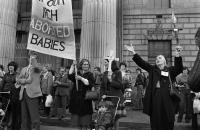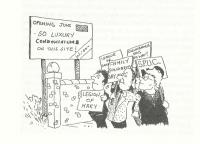Breaking the silence on abortion:the 1983 referendum campaign
Published in 20th Century Social Perspectives, 20th-century / Contemporary History, Features, General, Issue 2 (March/April 2013), Volume 21
An anti-abortion rally outside the GPO in the early 1980s. (Derek Spiers)
The passing of the 1967 Abortion Act that legalised abortion in the United Kingdom (excluding Northern Ireland) was a source of controversy in the Irish Republic, where access to contraception was illegal. After 1967, increasing numbers of Irish women availed of access to abortion services in Britain while the debate about women’s right to control their own fertility carried on against a background of difficult legal cases. In 1981 the Pro-Life Amendment Campaign (PLAC) secured pre-election promises from both Fianna Fáil and Fine Gael to amend the constitution to ensure that abortion could not be introduced either by legislation or by the courts. Many Catholic bishops and priests spoke out in favour of the amendment, but all the other mainstream churches opposed it. Fianna Fáil backed the proposal, Fine Gael was divided, and Labour and the Workers’ Party and liberal forces generally opposed it, although all stressed that they were not advocating the legalisation of abortion.
Political background
John was involved in campaigning for social change and a more secular and liberal ethos in Ireland. He remembered the political background to the referendum:
‘I think the group around—was it the PLAC, Cornelius O’Leary and Julia Vaughan and all of them?—they could see the writing on the wall with the way things were going and I mean the way they did it was actually quite shrewd. They initially got the commitment from Fine Gael and Garret Fitzgerald . . . Fianna Fáil of course had a total[ly] reactionary position on it but they weren’t actually intending to jump on the anti-choice bandwagon but when Fine Gael did it, Fianna Fáil panicked and decided okay, we’d better go for it as well.’
Many of the activists who were involved in the Anti-Amendment Campaign had previous experience of working to change the laws against contraception and Glenys remembered that their tactics included deliberately flouting the law:
‘We got some contraceptives, we got some condoms—and took them to places and sold them. We took them to UCC and I remember all the security men came and bought them and it really wasn’t to sell condoms, it was just to challenge the law. It was just to say this is ridiculous. And we went up to the north side of the city and we had the Special Branch parked watching us so we didn’t actually sell them, we gave them away.’
Little evidence of pro-choice activity before the referendum
The referendum followed nearly a quarter-century of unprecedented change in Ireland but women’s rights were not high on the political agenda. There was little evidence of conscious pro-choice activity in Ireland before the referendum, as Alan recalled:
‘Prior to that there had been individuals, most notably Noel Browne, the Labour and subsequently the Socialist Labour Party TD, who did on several occasions call for what he described as therapeutic abortion to be available in Ireland but no, essentially it wasn’t an issue that was talked about and didn’t really figure on anybody’s radar until 1980 when a small group formed in Dublin, the Women’s Right to Choose Group, with the intention of beginning to break the silence and force the issue into the public domain.’
The forces responsible for embedding the anti-abortion position in the Irish constitution were often portrayed as defenders of traditional Irish culture and values. The role played by the Catholic Church and its devotees was an intrinsic element of that defence. Archbishop Kevin MacNamara of Dublin was the author of a pamphlet published as part of PLAC’s campaign literature. The following extract illustrates the tone of the document:
‘A vote in favour of the amendment (i.e. a ‘Yes’ vote) will be a vote that some unborn children in the future will not be put to death, but allowed to be born and live. A vote against the amendment, or failure to vote at all, will be—whether one intends it or not—to opt for leaving the existing legal protection of the unborn child at risk, and open to an unrelenting and ever-increasing attack.’
‘Capitalism and Marxism united in the fight for abortion on demand’
Anti-abortion campaigners portrayed abortion as inherently evil and there were repeated suggestions that Irish women were being led astray by sinister forces from outside the country. The Life Education and Research Network (LEARN) published a booklet, Abortion now, in early 1983. One of the chapters was written by Loretto Brown, a founding member of the Society for the Protection of the Unborn Child (SPUC), and she summarised the perceived threat as follows:
‘We must recognise the modus operandi of the anti-life lobby. It can truly be said that capitalism and Marxism are united in the fight for abortion on demand; the one for money, the other for ideological reasons. The average Russian woman has six abortions per lifetime; and in China, women pregnant for the third time are automatically aborted by law. Recalcitrants are forcibly brought to state abortion clinics while their husbands are imprisoned and the family home locked up . . . We must remember that those who choose to travel to Britain for abortions do so for social reasons. It is inconceivable that a woman whose life was deemed to be endangered would be advised to travel so far in an ill condition.’
Glenys had moved to Ireland from England and she remembered that she had only been in Cork for two weeks when she was asked how to procure an abortion:
‘It was somebody I’d met and they asked me, I think it was for their daughter, and it was all very hush-hush but the assumption was that because I was English that I must know all about these things and I found that quite shocking too.’

A cartoon on p. 22 of No more chains that poked fun at the anti-contraception hysteria of some pro-amendment activists.
While there was very little possibility of any meeting of minds on the issue, the referendum campaign was particularly marked by the extreme behaviour of some of the pro-amendment activists. Many opponents of the amendment remembered being subjected to vicious verbal abuse on a regular basis but others recalled more violent incidents, including the dowsing of a campaigner with a bucket of what turned out to be pig’s blood. Such behaviour resulted in a split between the more extreme elements of the anti-abortion groups and those who claimed to represent the views of the majority of the Irish people.
In 1983 the focus of the Anti-Amendment Campaign was simply on securing a rejection of the eighth amendment. There was a 53.7% turnout to vote and the amendment was carried by 66.4% to 32.9% of the valid poll. Some individuals and groups tried to raise public consciousness about abortion in the context of women’s rights and they felt that the 1983 referendum offered the opportunity to make arguments that might not otherwise be possible.
Most of the people who were active in the 1983 Anti-Amendment Campaign believed that there was no need for a referendum to outlaw a procedure that was already illegal. Others believed that the measure was sectarian and were voting against it to maintain the status quo. During this and later campaigns, there seems to have often been a tacit agreement with friends and workmates not to discuss the issue overtly, although there were instances, particularly during the X Case in 1992, when that was not the case. Sometimes there were significant differences with family members that also reflected the experience of activists when canvassing for a pro-choice position. Donal remembered one encounter:
‘My father had died a year or two years previously and his sister was a nun . . . We were standing in Daunt Square and I happened to be handing out those anti-amendment leaflets and I was standing under a poster, it was a SPUC poster of a graphic foetus, you know the whole abortion picture. So she came along and a beatific smile came across her. She went “oooh” as if I’d been sort of rescued from everything she assumed I was. Even though she would have known I was vaguely politically active and long-haired and not quite pious this was beyond her comprehension because when I handed her the leaflet and said “vote no to the amendment” and so on, she completely freaked and her face was contorted into hatred and she said “your father would be ashamed and your father’s not cold in his grave” and she ripped up the leaflet and threw it in my face. Now everyone else assumed it was just another mad nun, you know, but it was my aunt . . . and she stormed off. It was genuinely shocking to me—the level of it, you know?’
Alan explained that there were differences on the anti-amendment side between those who thought the forces of reaction should be faced down and others who were worried about excessive radicalism alienating the electorate:
‘People may not fully grasp it these days, the tension between the cautious and the not so cautious. I was just reminded; during the 1983 referendum the Workers’ Party achieved the seemingly impossible. Their leaflet, which was calling for a No vote, not only did it not mention abortion, it didn’t even mention women. Now that’s caution par excellence.’
The 1992 X Case
The appeal to traditional values that was so successful in 1983 has since been tempered by the understanding that the issue was not as clear-cut as had been claimed. In relation to the X Case in 1992, all the activists belie
![‘The abortion mills of England grind Irish babies into blood that cries out to heaven for veangeance [sic]’—SPUC banner at an October 1982 counter-picket of a Northside Anti-Amendment Group meeting in the Black Sheep pub, Coolock. The group, which disrupted the meeting, was led by Una Bean Mhic Mhathuna (left) and Mina Bean Uí Chroibín (right), seen here making her point very forcefully. (Derek Spiers)](/wp-content/uploads/2013/03/Breaking-the-silence-on-abortionthe-1983-referendum-campaign-3.jpg)
‘The abortion mills of England grind Irish babies into blood that cries out to heaven for veangeance [sic]’—SPUC banner at an October 1982 counter-picket of a Northside Anti-Amendment Group meeting in the Black Sheep pub, Coolock. The group, which disrupted the meeting, was led by Una Bean Mhic Mhathuna (left) and Mina Bean Uí Chroibín (right), seen here making her point very forcefully. (Derek Spiers)
‘There’s been a huge sea change because I think there’s been more openness. I mean with the changes, the radical changes that happened—you know accessibility to contraception, you can travel now to have an abortion, and you won’t be prosecuted if you’re gay, there’s an acceptance that society isn’t all “mammy, daddy, two children, car, cat, dog and budgie”, you know what I mean, that there’s not that nuclear family?’
For the most part, opponents of the amendment saw themselves as promoting a more open, liberal society in which traditional authority figures would be replaced by political representatives who thought outside the old certainties of nationality and religion. The debate about abortion that still continues is now much more about the practicalities than the principles but the issue is still central to any analysis of women’s status in 21st-century Ireland. HI
Mary Muldowney is a founding member of the Oral History Network of Ireland and a visiting research fellow in the Centre for Contemporary History, Trinity College, Dublin.
b>Further reading:
J. Kingston & A. Whelan (with I. Bacik), Abortion and the law (Dublin, 1997).
M. Ruane, The Irish journey: women’s stories of abortion (Dublin, 2000).
L. Smyth, Abortion and nation: the politics of reproduction in contemporary Ireland (Aldershot, 2005).
















